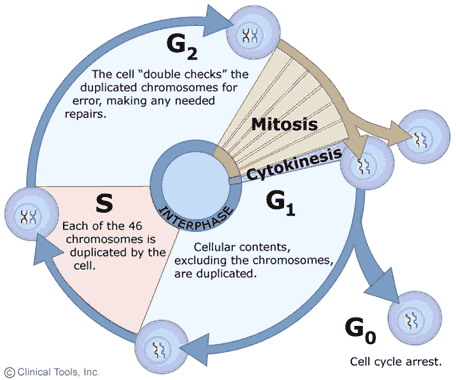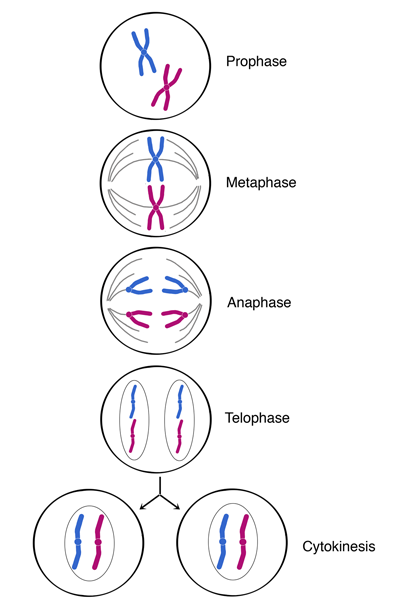Mitosis
Purposes of mitosis: How do cells duplicate themselves, and why? In all complex multicellular organisms (eukaryotes), cell duplication occurs by a process called "mitosis" or cell division. Cells divide for two reasons:
- Growth. We all started out as a single cell; the fusion of a sperm from dad and an egg from mom. That original cell divided repeatedly until you grew and differentiated into an organism composed of billions of cells. But this raises an interesting problem. When one cell divides into two, both must have a copy of the genetic information. Therefore, before cell division occurs, the genes must also make duplicates of themselves so that all of the important genetic information ends up in each of the new cells. The first cell divides into two, and each of those two divide again, and this process continues geometrically along the following progression: 1, 2, 4, 8, 16, 32, 64, 128, and so on into the billions. That's growth.
- Repair. Cells are constantly wearing out and getting damaged, and unless an organism replaces them at least as fast as they are lost, a gradual deterioration will occur. (If you're perceptive, you'll point out that we're not just a giant blob of billions of identical cells. Good point. Although each cell contains the complete blueprint (the genome) for how to build the body, only certain parts of it get read and acted upon, depending on the eventual function of that cell. Cells differentiate and become specialized for a particular purpose, but that's a story for another day.) In the figure below, blue represents genetic contributions from dad and pink represents genetic contributions from mom. In this simple example, a diploid body cell contains 2n = 2 chromosomes. One chromosome came from mom and one from dad. In humans, 2n = 46, so 23 came from mom, and 23 from dad.
Interphase: Each chromosome undergoes replication, making an identical copy of itself. At this point, the chromosomes are still long and thin, and are not visible inside the nucleus. Cells spend most of their life in this non-dividing phase. See the graphic below.
Prophase: The chromosomes coil and shorten, and become visible. It becomes apparent that the chromosomes have duplicated. Pairs of identical chromosomes remain attached to each other at the centromere and each chromosome is called a chromatid.
Metaphase: Chromosomes line up along the center of the cell. A pair of structures called centrioles form at the poles of the cell, and produce spindle fibers which attach to the centromeres of each chromosome pair.
Anaphase: The paired chromosomes split at the centromere and the two halves migrate along the spindle fibers to opposite sides of the cell. At the same time, the center of the cell begins to pinch.
Telophase: Cell division occurs, and each is identical to the original. Cells return to Interphase and prepare for another round of division.

The blue arrow represents Interphase, where the cell is not undergoing mitosis.


